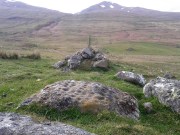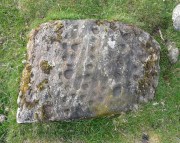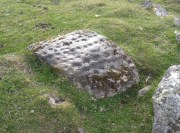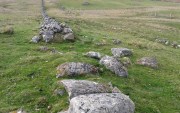Cup-Marked Stone: OS Grid Reference – NN 65022 38285
Also Known as:
Take the A827 road that runs alongside Loch Tay between Killin and Kenmore, and about 6 miles from Killin watch out for the signposts for The Big Shed. Stop and walk NW up the track across the road from there, up toward Ben Lawers. Several hundred yards up, past the sheep-fold on the left-side of the track, a line of ruinous walling runs straight over the grasslands. Walk along here until it meets with the next walling that runs uphill. Look down into where the wall has collapsed. It’s under your nose!
Archaeology & History
This is a fascinating and pretty impressive example of a simple cup-marked stone. It’s the design that does it I suppose – similar in some ways to the well-known Idol Stone carving on my old playground of Ilkley Moor (that’s what this one reminded me of when I first clapped eyes on it)—but much better!
Its similarity lies in the series of parallel rows of cup-marks running very close together along the line of the low-lying rock, found at the base of some ancient walling that runs up the mountain for several hundred yards. Not only that, but the line of walling itself also has a parallel line of walling running adjacent for the same distance up the mountainside — more than half-a-mile from start to finish. This “parallel” feature of walling and cup-markings is a curious coincidence, perhaps. But certainly the linearity of the cup-marks was itself a very deliberate feature by the person who carved it, representing something ‘structural’, in whatever mythic form that may have been!
Of the rows of cups constituting this petroglyph, four of them run completely from one side of the stone to the other, rough north to south; with four other shorter rows running only halfway across the rock surface. Altogether there are perhaps seventy cups etched onto the rock. No rings or semi-circles of any form were visible in our visit here—although the skies were grey and overcast, making any decent visual analysis more difficult.
A damn good carving and well worth checking out by anyone into prehistoric rock art!
© Paul Bennett, The Northern Antiquarian



